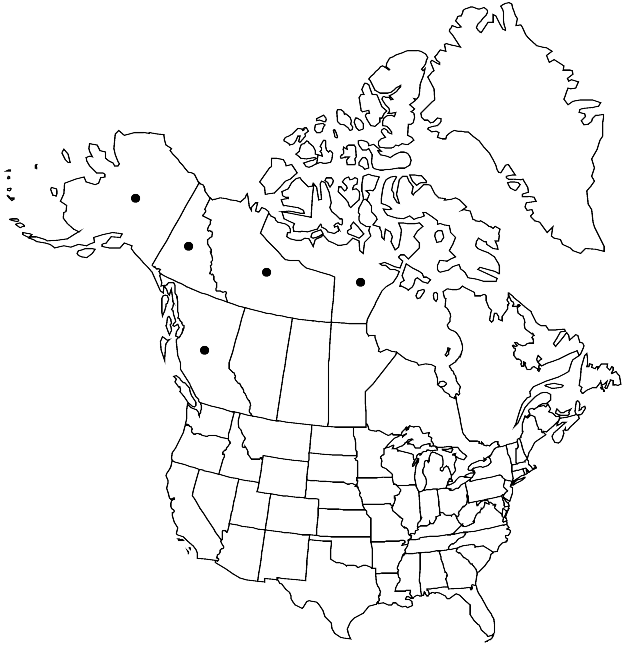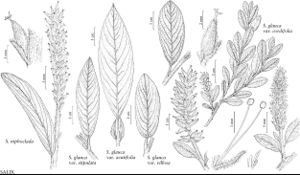Salix niphoclada
Bull. New York Bot. Gard. 1: 272. 1899.
Plants 0.3–1.5(–3) m, not clonal. Stems erect, decumbent, or trailing; branches gray-brown, yellow-brown, or red-brown, pilose, villous, or long-silky to glabrescent; branchlets violet, red-brown, or yellow-brown, pilose, densely villous, long-silky, or tomentose. Leaves: stipules (sometimes marcescent), foliaceous, (sometimes obscured by hairs); petiole (shallowly grooved adaxially), 2–5.5 mm, (usually shorter than or barely exceeding subtended bud, villous adaxially); largest medial blade hypostomatous or amphistomatous, narrowly oblong, narrowly to broadly elliptic, lanceolate, or obovate, 13–64 × 6–22 mm, 1.6–5.5 times as long as wide, base convex, margins slightly revolute, entire (obscured by hairs), apex acuminate or acute, abaxial surface densely villous or woolly to pilose, hairs straight or wavy, adaxial slightly glossy, moderately densely to sparsely villous; proximal blade margins entire; juvenile blade abaxially densely long-silky. Catkins: staminate 12–42 × 4–14 mm, flowering branchlet 0–20 mm; pistillate densely flowered, slender, stout, or subglobose, 16–69 × 4–13 mm, flowering branchlet 4–30 mm; floral bract tawny, brown, or black, 1.2–3.2 mm, apex rounded, entire, abaxially sparsely to moderately densely hairy, hairs wavy. Staminate flowers: abaxial nectary 0.5–1.2 mm, adaxial nectary narrowly oblong to ovate or flask-shaped, 0.5–1.5 mm, nectaries distinct or connate and cup-shaped; filaments distinct, glabrous, or sparsely hairy on proximal 1/2; anthers ellipsoid or globose, 0.3–0.5 mm. Pistillate flowers: abaxial nectary rarely present, 0.7 mm, adaxial nectary narrowly oblong, ovoid, or flask-shaped, 0.5–2 mm, longer than stipe; stipe 0–0.5 mm; ovary pyriform, very densely villous or long-silky, beak slightly bulged below or abruptly tapering to styles; ovules 8–20 per ovary; styles connate to almost distinct, 0.2–0.8 mm; stigmas slenderly to broadly cylindrical, 0.2–0.36–0.6 mm. Capsules 4–6 mm.
Phenology: Flowering Jun–Jul.
Habitat: Wet to moderately well-drained calcareous, gravelly or sandy floodplains, terraces, eskers, drumlins, fine, silty loess deposits, dry to mesic stony alpine slopes and saline flats, limestone talus, sand blowouts, plains
Elevation: 10-2300 m
Distribution

B.C., N.W.T., Nunavut, Yukon, Alaska, Asia (Russia).
Discussion
Salix niphoclada was treated as S. brachycarpa subsp. niphoclada (G. W. Argus 1965, 1973) because where the ranges of the two taxa overlap in northern British Columbia they appeared to intergrade. Species rank is used here, however, because there is no evidence to suggest that intergradation is common or extends beyond the small area of overlap.
Salix brachycarpa var. fullertonensis, which mainly occurs in southern Nunavut and the western side of Hudson Bay, is characterized by smaller leaves and catkins, broad, reddish floral bracts, and more sparsely hairy branchlets (G. W. Argus 1965). Its intergradation with S. niphoclada is so extensive that it is not recognized here as a separate taxon.
Hybrids:
Salix niphoclada forms natural hybrids with S. glauca var. acutifolia and S. setchelliana.
Salix niphoclada × S. setchelliana is a putative hybrid from Sheep Mountain, Kluane, Yukon, at 1180 m. It resembles S. niphoclada in leaf shape and indumentum, stigmas 0.6 mm, floral bracts oblong, 1.8 mm, and in the shape and length of pistillate catkins, but it has the glabrous, reddish ovaries of S. setchelliana. Both putative parents occur in the area.
Selected References
None.
